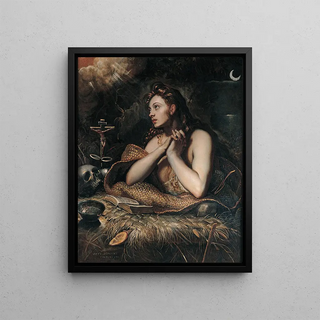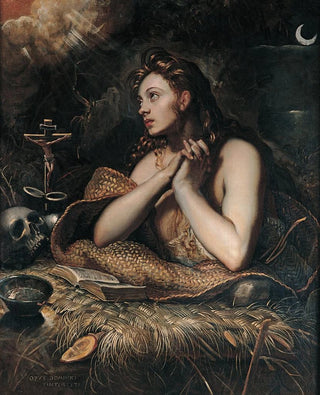Art print | Madeleine pénitente - Jacopo Tintoretto


View from behind

Frame (optional)
In the fascinating universe of art history, certain artworks stand out for their ability to capture the human essence in all its complexity. "Madeleine pénitente" by Jacopo Tintoretto is one of these iconic creations. Painted in the 16th century, this piece not only showcases the undeniable talent of its artist but also reflects an era where sacred art and the depiction of human emotions intertwine with rare intensity. Madeleine, the central figure of this painting, embodies the duality of suffering and redemption, a theme that resonates deeply through the ages. Contemplating this work invites the viewer to reflect on the nature of penance and the quest for light within darkness.
Style and uniqueness of the work
Tintoretto's style is characterized by an exceptional mastery of chiaroscuro and a dynamic composition that gives his works a palpable energy. In "Madeleine pénitente," light plays a crucial role, illuminating Madeleine's face while casting the rest of the scene into suggestive shadow. This use of light accentuates her facial features, revealing an expression of melancholy and contemplation. Madeleine's posture, leaning and introspective, evokes a psychological depth that transcends a simple portrait. The richness of colors, from warm browns to golden highlights, creates an atmosphere that is both intimate and spiritual, inviting the viewer to immerse themselves in the thoughts of this woman in search of redemption. Every brushstroke seems charged with meaning, testament to Tintoretto's skill in breathing life into his characters.
The artist and his influence
Jacopo Tintoretto, born in 1518 in Venice, is often regarded as one of the masters of Venetian Renaissance painting. His work, marked by remarkable boldness and originality, has exerted a lasting influence on many artists. Tintoretto stands out for his ability to combine the grandeur of classical tradition with a more personal and expressive approach. His technique, which favors quick gestural strokes and a vibrant palette, allows him to create dynamic compositions.

Matte finish

View from behind

Frame (optional)
In the fascinating universe of art history, certain artworks stand out for their ability to capture the human essence in all its complexity. "Madeleine pénitente" by Jacopo Tintoretto is one of these iconic creations. Painted in the 16th century, this piece not only showcases the undeniable talent of its artist but also reflects an era where sacred art and the depiction of human emotions intertwine with rare intensity. Madeleine, the central figure of this painting, embodies the duality of suffering and redemption, a theme that resonates deeply through the ages. Contemplating this work invites the viewer to reflect on the nature of penance and the quest for light within darkness.
Style and uniqueness of the work
Tintoretto's style is characterized by an exceptional mastery of chiaroscuro and a dynamic composition that gives his works a palpable energy. In "Madeleine pénitente," light plays a crucial role, illuminating Madeleine's face while casting the rest of the scene into suggestive shadow. This use of light accentuates her facial features, revealing an expression of melancholy and contemplation. Madeleine's posture, leaning and introspective, evokes a psychological depth that transcends a simple portrait. The richness of colors, from warm browns to golden highlights, creates an atmosphere that is both intimate and spiritual, inviting the viewer to immerse themselves in the thoughts of this woman in search of redemption. Every brushstroke seems charged with meaning, testament to Tintoretto's skill in breathing life into his characters.
The artist and his influence
Jacopo Tintoretto, born in 1518 in Venice, is often regarded as one of the masters of Venetian Renaissance painting. His work, marked by remarkable boldness and originality, has exerted a lasting influence on many artists. Tintoretto stands out for his ability to combine the grandeur of classical tradition with a more personal and expressive approach. His technique, which favors quick gestural strokes and a vibrant palette, allows him to create dynamic compositions.






